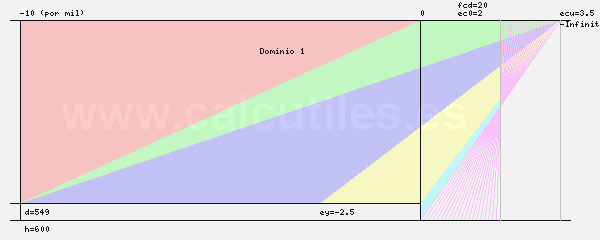Home
Calculation utilities
Loads
SteelConcreteGeotecnics
| (*)
Only for users with an active subscription (+info) |
General informationContact
| |
Calc-útiles Pino - Structural calculation utilities - Sponsors:




|
Calculation of the maximum efforts of the reinforced concrete section to bending and axial. Generating of the interaction diagram, both
according to the parable-box diagram as the rectangular digram of the concrete, and the strain domains diagram, according to the EHE-08.Abstract- The interaction diagram of the concrete section is developed according to EHE-08,
with the behavior of concrete specified in Article 39.5, following both the parable-box diagram
as the rectangular stress-strain diagram of the concrete.
In this interaction diagram, the combination of the maximum axial and bending moments of the section is obtained from the
maximum deformation that admits the section, according to the diagram of deformation domains described in Article 42.
- The domain deformation diagram is generated from the maximum admissible deformation of
concrete and steel, when considering the neutral axis moving from -∞ to +∞.
- The interaction diagram is obtained by calculating for each position of the neutral axis,
the balance of forces and moments about the midpoint of the concrete section.
- The forces and moments of the reinforcements are calculated by adding each steel bar. The forces
and moments of the concrete are calculated based on the compressed concrete area from the parabola-rectangle diagram
and the rectangular diagram.
- The domain deformation diagram is as follows:

Calculation
Author's notes
- These calculations proposed by the regulation are very accurate and instructive, but
in the author's opinion, its accuracy is dissolved in practice when sizing elements with load
increment factors of a magnitude order as high as the current 1.35 and 1.5.
- In concrete sections with unsymmetrical reinforcements or covers, the balance in
pure traction or compression at both extremes is not reached, appearing moments in axial extreme values.
- Although at the EHE 08 the fatigue factor has increased by around 17% compared to
the EHE 98 (from 0.85 to 1), the maximum resistant efforts of the section are not increased this percentage,
but at much lower percentages. In fact it has been observed that in some cases the maximum tension stress and the
maximum bending moment are reduced. With this it seems that to make the calculations
with the fatigue factor as EHE-98 is not in all cases on the safety side.
Version 15/11/2012
|
|